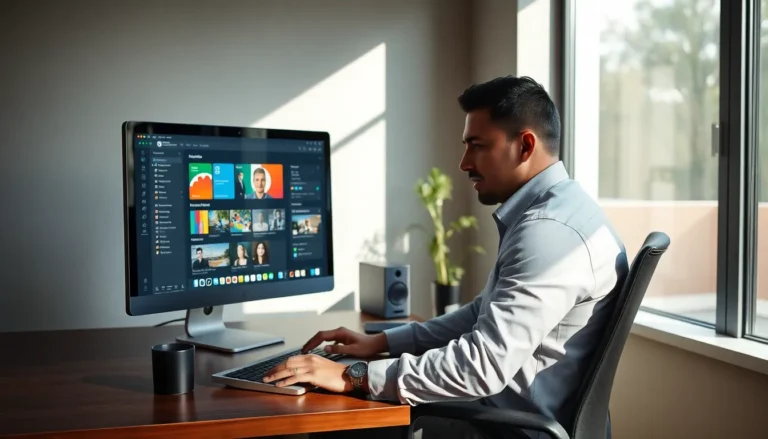Table of Contents
ToggleEffective classroom management is the backbone of a successful learning environment. It’s not just about maintaining order; it’s about creating a space where students feel safe, engaged, and motivated to learn. Teachers face the challenge of balancing diverse personalities and learning styles while fostering a culture of respect and collaboration.
With the right strategies in place, educators can transform their classrooms into dynamic hubs of creativity and critical thinking. From establishing clear expectations to employing engaging teaching methods, effective classroom management techniques empower teachers to enhance student outcomes. As classrooms evolve, understanding the nuances of classroom management becomes essential for educators aiming to inspire the next generation.
Understanding Classroom Management
Classroom management encompasses the techniques and strategies educators use to maintain an effective learning environment. By focusing on organization, student engagement, and discipline, teachers can foster an atmosphere conducive to learning.
Definition of Classroom Management
Classroom management refers to the practices and methods educators implement to facilitate a productive learning environment. These include establishing clear expectations, developing routines, and managing student behavior. Effective classroom management promotes order and inclusivity while addressing individual student needs.
Importance of Classroom Management
Classroom management plays a crucial role in student success. By fostering a structured environment, educators can enhance student motivation and participation. Key benefits include:
- Enhanced focus: Students concentrate better in well-managed classrooms.
- Reduced disruptions: Efficient management minimizes classroom interruptions, allowing for more instructional time.
- Improved relationships: Positive management strategies cultivate mutual respect between teachers and students.
- Increased academic performance: A supportive environment directly correlates with higher student achievement.
- Skill development: Students develop essential life skills such as self-discipline and responsibility within a managed space.
By understanding classroom management, educators can apply effective strategies that motivate and engage students, ultimately leading to improved educational outcomes.
Key Components of Effective Classroom Management


Effective classroom management relies on key components that structure a productive learning environment. These components focus on setting clear guidelines, fostering relationships, and engaging students.
Establishing Rules and Procedures
Establishing rules and procedures creates a framework for behavior in the classroom. Educators must outline specific expectations, making sure students understand them clearly. Common practices include:
- Clarity: State rules in simple, direct language. For instance, “Raise your hand to speak” emphasizes respectful communication.
- Consistency: Enforce rules uniformly to build trust and reliability. Inconsistent application may lead to confusion and misbehavior.
- Involvement: Engage students in the rule-setting process. When students help create guidelines, they may feel more invested in following them.
- Visibility: Display rules prominently in the classroom. Visual reminders reinforce expectations throughout the school year.
- Reinforcement: Regularly acknowledge positive behavior related to rules. Recognition or rewards boost motivation and compliance.
Building Relationships with Students
- Communication: Maintain open lines of communication. Regular check-ins allow teachers to understand student needs and concerns.
- Empathy: Show understanding of students’ experiences. Displaying empathy can create trust and strengthen student-teacher relationships.
- Encouragement: Promote a growth mindset. Encourage students to view challenges as opportunities for learning, which fosters resilience.
- Involvement: Get to know students’ interests and strengths. Tailoring activities to their preferences can make learning more relevant and engaging.
- Support: Provide emotional and academic support. When students feel supported, their likelihood of success and cooperation increases.
Strategies for Successful Classroom Management
Effective classroom management strategies foster a positive and productive learning environment. Utilizing specific techniques can enhance student engagement and address disruptive behavior effectively.
Techniques for Engaging Students
- Incorporating Interactive Activities: Implement hands-on tasks, discussions, or group work that encourages student participation.
- Utilizing Technology: Integrate educational technology tools like interactive whiteboards or learning apps to capture students’ interest.
- Differentiating Instruction: Tailor lessons to meet varying learning styles, ensuring all students can connect with the material.
- Setting Clear Objectives: Communicate specific learning goals to provide a sense of direction and purpose.
- Encouraging Student Autonomy: Offer choices in assignments or project topics, promoting ownership of their learning experience.
Addressing Disruptive Behavior
- Establishing Clear Expectations: Define rules clearly and reinforce them consistently to minimize misunderstandings.
- Utilizing Positive Reinforcement: Recognize and reward appropriate behavior, encouraging a positive classroom atmosphere.
- Implementing Proactive Measures: Monitor student interactions and proactively address potential disruptions before they escalate.
- Building Strong Relationships: Foster a supportive rapport with students to create a safe environment for addressing behavioral issues.
- Applying Calm Intervention Techniques: Use calm and controlled responses to redirect disruptive behavior effectively, maintaining a composed classroom atmosphere.
The Role of Technology in Classroom Management
Technology plays a vital role in classroom management by enhancing organization, communication, and student engagement. By leveraging digital tools, educators can improve the learning environment and streamline their classroom management tasks.
Utilizing Digital Tools
Utilizing digital tools enhances classroom efficiency and engagement. Platforms like Google Classroom and Microsoft Teams facilitate communication between educators and students. Educators can share resources, assign tasks, and provide feedback quickly and efficiently. Classroom management apps, such as ClassDojo and Classcraft, allow teachers to track student behavior and participation in real time. These apps foster a positive classroom environment by rewarding positive behavior and encouraging student accountability. Moreover, video conferencing tools enable remote learning and provide additional avenues for interaction, maintaining a cohesive classroom community.
Online Classroom Management Strategies
Online classroom management strategies establish structure and support in virtual or hybrid learning environments. Setting clear guidelines for online behavior ensures students understand expectations. Regular check-ins during class sessions help maintain engagement and provide opportunities for feedback. Implementing breakout rooms encourages collaborative learning, allowing students to interact in smaller groups. Incorporating multimedia resources, such as videos and interactive quizzes, captures student interest and promotes active participation. Moreover, using analytics provided by learning management systems allows educators to identify trends in student performance, enabling timely interventions and tailored support.
Challenges in Classroom Management
Educators encounter various challenges in classroom management that can impact student learning and engagement. These challenges often stem from diverse student needs, behavior issues, and the complexity of maintaining an orderly environment.
Common Issues Faced by Educators
- Diverse Learning Styles: Educators often deal with a classroom full of students who possess different learning preferences. Catering to visual, auditory, and kinesthetic learners simultaneously can prove difficult.
- Behavioral Disruptions: Frequent disruptions from students, whether through talking out of turn or engaging in off-task behavior, hinder the learning process and distract others.
- Lack of Motivation: Some students exhibit low motivation levels, which affects their participation and overall performance in the classroom.
- Time Constraints: Within limited class time, educators must cover substantial curriculum material while also managing classroom activities, making it challenging to focus on individual student needs.
- Inconsistent Support: Varying levels of support from families, administrators, and other staff can complicate classroom management efforts and reduce the effectiveness of interventions.
Solutions to Overcome Challenges
- Adapt Instruction: Implementing differentiated instruction techniques allows educators to tailor lessons to various learning styles, ensuring engagement for all students.
- Establish Clear Rules: Developing and communicating specific rules and expectations provides students with a clear understanding of acceptable behavior, reducing the likelihood of disruptions.
- Enhance Engagement: Utilizing interactive activities and technology fosters student participation. Engaged students are less likely to exhibit disruptive behavior.
- Incorporate Positive Reinforcement: Rewarding positive behavior through incentives and recognition encourages students to stay on task and participate actively.
- Build Strong Relationships: Establishing rapport with students creates a supportive environment. Students who feel respected and valued are more likely to engage with the learning process.
- Utilize Data: Analyzing performance data allows educators to identify trends and address specific issues proactively. This approach enhances tailored interventions and support strategies.







